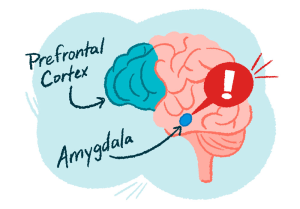Have you ever felt super motivated to start something—a new fitness routine, tackling a big project, or even just clearing out your inbox—but when the time comes to actually do it, the motivation is nowhere to be found? It’s a frustrating, all-too-common experience, and it’s one we see with our clients every day.
Clients often show up engaged and ready to participate, but when it comes to taking consistent action, barriers like fear, overwhelm, or a lack of confidence can hold them back. As Exercise Physiologists, we have to understand how to get past this. After all, action is where real progress happens, and it’s our job to guide clients toward taking those critical steps.
That’s where neuroscience comes in. By understanding the brain’s role in motivation, decision-making, and fear, we can tailor our approach to engage clients on a deeper level, breaking through hesitation and turning intentions into meaningful action.
The Science of Taking Action
Taking action isn’t always as simple as deciding to do something. It involves a complex interplay of motivation, emotion, and cognition—factors deeply rooted in the brain.
- The Prefrontal Cortex: The Decision-Making Hub
The prefrontal cortex is responsible for planning, decision-making, and self-control. When clients feel overwhelmed by their injury or rehabilitation goals, this part of the brain can become overtaxed, leading to procrastination or avoidance.
- Dopamine: The Motivation Molecule
Dopamine plays a crucial role in driving action. When we anticipate a reward—like achieving a goal or feeling better after a workout—dopamine levels spike, making us more likely to act. However, if a task feels too daunting or the reward seems too far away, the dopamine hit isn’t strong enough to inspire action.
- The Amygdala: Fear and Resistance
The amygdala governs fear and emotional responses. For clients recovering from injuries, the fear of pain, failure, or even judgment can activate the amygdala, creating resistance to taking action.

How We Turn Neuroscience Into Action at Specialised Health
Understanding these brain mechanisms helps us create strategies to engage clients and empower them to take action. Here’s how we do it:
1. Breaking Goals Into Bite-Sized Chunks
Clients often feel overwhelmed by the thought of returning to pre-injury duties or achieving long-term rehabilitation goals. To combat this, we use the concept of micro-goals. By focusing on smaller, achievable steps—like increasing range of motion by 10 degrees or lifting 1 kg more this week—we trigger the dopamine response and build momentum.
Example: Guiding a client hesitant to resume lifting heavy loads to start with small, manageable weights, celebrating each progression along the way. This not only built their physical capacity but also boosted their confidence.
2. Making It Meaningful
People are more likely to act when they connect emotionally with their goals. We take time to understand why our clients want to return to work and build function. Is it to support their family? To regain independence? By linking rehabilitation tasks to their personal motivations, we activate their intrinsic drive.
Example: For a client who loves gardening, we may incorporate functional exercises mimicking tasks like lifting pots or weeding, making the program feel directly relevant to their life.
3. Normalising Setbacks and Building Resilience
Fear of failure or setbacks often holds people back. We address this by normalising setbacks as part of the journey and reframing challenges as opportunities for growth. This helps quiet the amygdala’s fear response and fosters a growth mindset.
Example: A client struggling with pain flare-ups during rehab being reminded that progress isn’t linear and that every session, even the tough ones, contributes to their overall success.
4. Celebrating Wins Along the Way
Celebration isn’t just for the end of the program—it’s a key motivator throughout. Recognising achievements, no matter how small, reinforces positive behavior and keeps dopamine flowing.
Example: When a client hit a milestone, like completing a full shift or mastering an exercise, we shared their progress with them and their referrer, highlighting their hard work and progress.
The Takeaway: Turning Engagement Into Action
The neuroscience of action shows us that engagement alone isn’t enough—clients also need the right environment, tools, and strategies to bridge the gap between intention and action.
Whether you’re helping your claimants move forward or working on your own goals, the same principles apply. Break tasks into achievable steps, celebrate progress, and focus on what truly motivates you. With the right support and strategies, action becomes possible—and progress becomes inevitable.
Author: Tessa Nielsen



